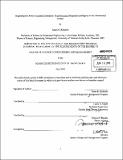Integrating the Army Geospatial Enterprise : synchronizing geospatial-intelligence to the dismounted soldier
Author(s)
Richards, James E., S.M. Massachusetts Institute of Technology
DownloadFull printable version (26.38Mb)
Alternative title
Integrating the AGE : synchronizing geospatial-intelligence to the dismounted soldier
Synchronizing geospatial-intelligence to the dismounted soldier
Other Contributors
System Design and Management Program.
Advisor
Donna H. Rhodes.
Terms of use
Metadata
Show full item recordAbstract
The Army's Geospatial Enterprise (AGE) has an emerging identity and value proposition arising from the need to synchronize geospatial information activities across the Army in order to deliver value to military decision makers. Recently, there have been significant efforts towards increasing the capability of the enterprise to create value for its diverse stakeholder base, ranging from the warfighter, to early stage research and development. The AGE has many architectural alternatives to consider as it embarks upon geospatial transformation within the Army, each of these alternatives must deliver value through an increasingly wide range of operating environments characterized by the uncertainty of both future technology and the evolution of future operations. This research focuses on understanding how the Army's geospatial foundation data layers propagate through the battlefield and enable well informed tactical decisions. The goal of this investigation is to develop heuristics to guide the transformation efforts currently underway within the Army's Geospatial Enterprise. A set of surveys and informal interviews with individuals in the Army geospatial community inform the "as-is" enterprise architecture. A system dynamics (SD) model is developed to simulate the current state enterprise at the enterprise boundary, where the AGE delivers value to the warfighters at the tactical level. Potential future state architectures are developed, simulated in the SD model, and evaluated against a changing environment using Epoch-Era analysis. The results do not attempt to optimize a desired future architecture for the AGE, but rather inform decision making early in enterprise development to assist the Army geospatial leadership to understand possible transformation trajectories. Several candidate architectures are developed and evaluated within the context of dynamic environmental conditions. Given lower resource availability, the best architectural choice is to focus on capturing the geospatial information obtained by Soldiers as they travel around the area of operations, learning about the terrain from experiences and interactions with local populations. As the level of funding increases, there is a significant jump in geospatial information if a geospatial sensor is deployed while at the same time synchronizing information dissemination and use. Aligning resources appropriately to a coordinated geospatial architectural approach is important to future military operations as new technologies continue to require increased geospatial information quality.
Description
Thesis (S.M. in System Design and Management)--Massachusetts Institute of Technology, Engineering Systems Division, 2010. "June 2010." Cataloged from PDF version of thesis. Includes bibliographical references (p. 124-126).
Date issued
2010Department
System Design and Management Program.; Massachusetts Institute of Technology. Engineering Systems DivisionPublisher
Massachusetts Institute of Technology
Keywords
Engineering Systems Division., System Design and Management Program.